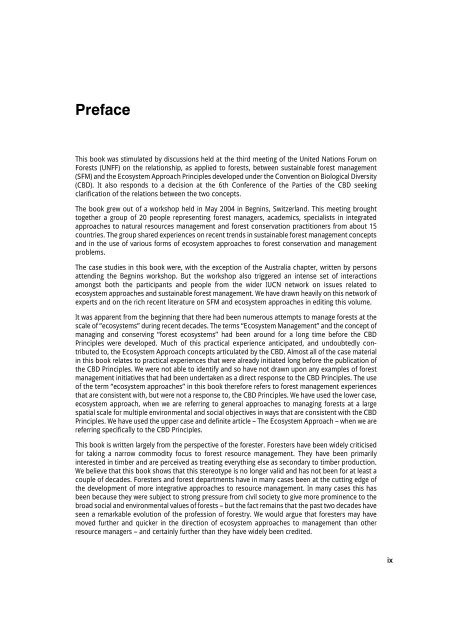Forests in Landscapes (2005) - PROFOR
Forests in Landscapes (2005) - PROFOR
Forests in Landscapes (2005) - PROFOR
- No tags were found...
You also want an ePaper? Increase the reach of your titles
YUMPU automatically turns print PDFs into web optimized ePapers that Google loves.
PrefaceThis book was stimulated by discussions held at the third meet<strong>in</strong>g of the United Nations Forum on<strong>Forests</strong> (UNFF) on the relationship, as applied to forests, between susta<strong>in</strong>able forest management(SFM) and the Ecosystem Approach Pr<strong>in</strong>ciples developed under the Convention on Biological Diversity(CBD). It also responds to a decision at the 6th Conference of the Parties of the CBD seek<strong>in</strong>gclarification of the relations between the two concepts.The book grew out of a workshop held <strong>in</strong> May 2004 <strong>in</strong> Begn<strong>in</strong>s, Switzerland. This meet<strong>in</strong>g broughttogether a group of 20 people represent<strong>in</strong>g forest managers, academics, specialists <strong>in</strong> <strong>in</strong>tegratedapproaches to natural resources management and forest conservation practitioners from about 15countries. The group shared experiences on recent trends <strong>in</strong> susta<strong>in</strong>able forest management conceptsand <strong>in</strong> the use of various forms of ecosystem approaches to forest conservation and managementproblems.The case studies <strong>in</strong> this book were, with the exception of the Australia chapter, written by personsattend<strong>in</strong>g the Begn<strong>in</strong>s workshop. But the workshop also triggered an <strong>in</strong>tense set of <strong>in</strong>teractionsamongst both the participants and people from the wider IUCN network on issues related toecosystem approaches and susta<strong>in</strong>able forest management. We have drawn heavily on this network ofexperts and on the rich recent literature on SFM and ecosystem approaches <strong>in</strong> edit<strong>in</strong>g this volume.It was apparent from the beg<strong>in</strong>n<strong>in</strong>g that there had been numerous attempts to manage forests at thescale of “ecosystems” dur<strong>in</strong>g recent decades. The terms “Ecosystem Management” and the concept ofmanag<strong>in</strong>g and conserv<strong>in</strong>g “forest ecosystems” had been around for a long time before the CBDPr<strong>in</strong>ciples were developed. Much of this practical experience anticipated, and undoubtedly contributedto, the Ecosystem Approach concepts articulated by the CBD. Almost all of the case material<strong>in</strong> this book relates to practical experiences that were already <strong>in</strong>itiated long before the publication ofthe CBD Pr<strong>in</strong>ciples. We were not able to identify and so have not drawn upon any examples of forestmanagement <strong>in</strong>itiatives that had been undertaken as a direct response to the CBD Pr<strong>in</strong>ciples. The useof the term “ecosystem approaches” <strong>in</strong> this book therefore refers to forest management experiencesthat are consistent with, but were not a response to, the CBD Pr<strong>in</strong>ciples. We have used the lower case,ecosystem approach, when we are referr<strong>in</strong>g to general approaches to manag<strong>in</strong>g forests at a largespatial scale for multiple environmental and social objectives <strong>in</strong> ways that are consistent with the CBDPr<strong>in</strong>ciples. We have used the upper case and def<strong>in</strong>ite article – The Ecosystem Approach – when we arereferr<strong>in</strong>g specifically to the CBD Pr<strong>in</strong>ciples.This book is written largely from the perspective of the forester. Foresters have been widely criticisedfor tak<strong>in</strong>g a narrow commodity focus to forest resource management. They have been primarily<strong>in</strong>terested <strong>in</strong> timber and are perceived as treat<strong>in</strong>g everyth<strong>in</strong>g else as secondary to timber production.We believe that this book shows that this stereotype is no longer valid and has not been for at least acouple of decades. Foresters and forest departments have <strong>in</strong> many cases been at the cutt<strong>in</strong>g edge ofthe development of more <strong>in</strong>tegrative approaches to resource management. In many cases this hasbeen because they were subject to strong pressure from civil society to give more prom<strong>in</strong>ence to thebroad social and environmental values of forests – but the fact rema<strong>in</strong>s that the past two decades haveseen a remarkable evolution of the profession of forestry. We would argue that foresters may havemoved further and quicker <strong>in</strong> the direction of ecosystem approaches to management than otherresource managers – and certa<strong>in</strong>ly further than they have widely been credited.ix
















